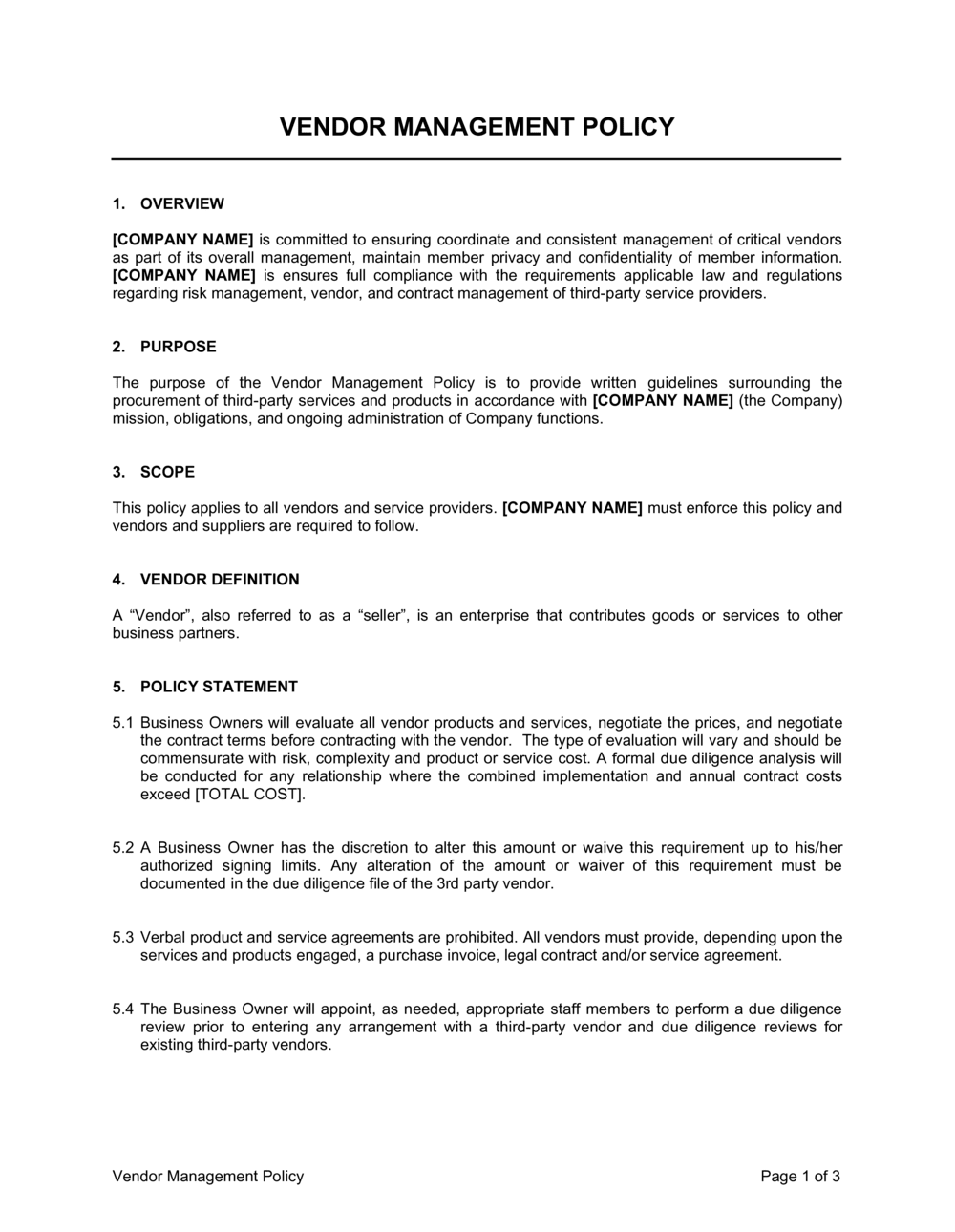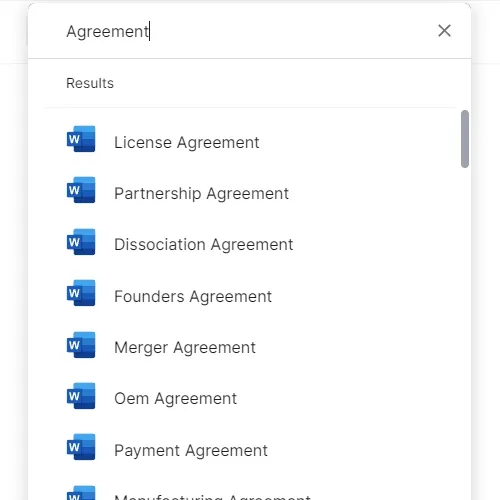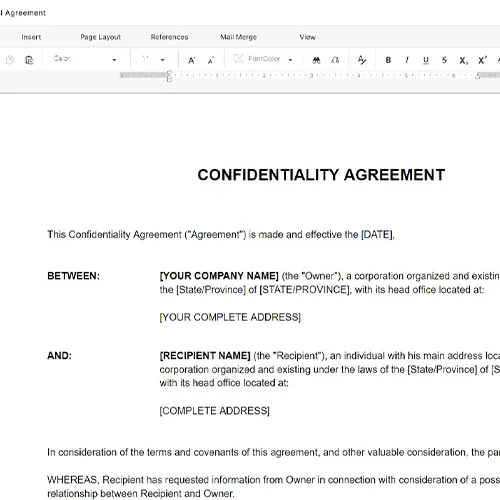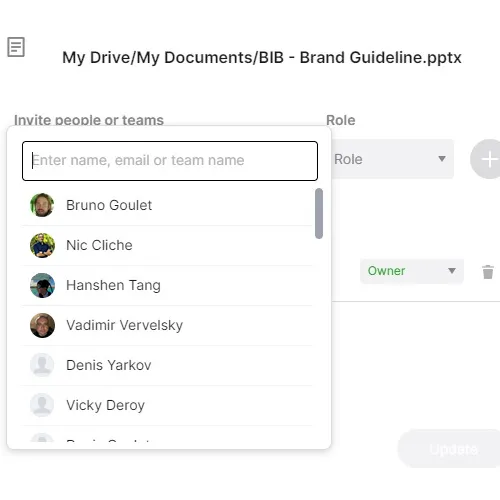Vendor Management Policy Template

Understanding a Vendor Management Policy
In the ever-changing world of business partnerships, having a clear and effective Vendor Management Policy is crucial for maintaining successful relationships with suppliers and vendors. This policy is like a set of rules that guide how a company works with its suppliers or vendors, providing a framework for interactions and collaborations. It's a way to ensure that the relationship between the company and its vendors is organized, fair, and productive, benefiting all parties involved. This article looks at what a Vendor Management Policy is, why it's important in the context of Supplier and Vendor templates, and what it should include to foster positive and sustainable partnerships.
What is a Vendor Management Policy?
A Vendor Management Policy is a document that outlines how a company selects, works with, and monitors its suppliers or vendors. It's like a roadmap that guides the company's actions when dealing with external parties that provide goods or services. This policy sets clear expectations, rules, and procedures to ensure that the company and its vendors collaborate effectively and ethically.
Key Components of a Vendor Management Policy
A well-crafted Vendor Management Policy comprises several essential components that together create a comprehensive framework for fostering successful collaborations between a company and its vendors. These key components are pivotal in establishing a seamless and mutually beneficial partnership:
1. Vendor Selection
This critical component delineates the criteria and processes involved in selecting vendors. Factors such as quality, pricing, reputation, and alignment with the company's values play a role in vendor selection. A clear understanding of the vendor selection process ensures that the chosen vendors are the right fit for the company's needs and objectives.
2. Contractual Agreements
The contractual agreements section outlines how contracts are structured between the company and its vendors. It defines the terms, responsibilities, and obligations of both parties, ensuring that expectations are clearly communicated and legally binding. A well-defined contract minimizes potential misunderstandings and disputes.
3. Performance Monitoring
This facet elucidates the procedures for monitoring vendor performance. Regular assessments and evaluations are essential to ensure that vendors are fulfilling their commitments and delivering the expected results. Early identification of performance issues allows for timely corrective actions.
4. Communication
Effective communication is the backbone of any successful partnership. This component outlines guidelines for communication between the company and its vendors. It covers areas such as dispute resolution, information sharing, and regular updates. Open and clear communication promotes transparency and prevents misunderstandings.
5. Risk Management
Businesses operate in a landscape of uncertainties, and risk management is crucial. This section delves into the identification, assessment, and mitigation of potential risks associated with vendors. By proactively addressing risks, the company can prevent disruptions and minimize negative impacts on operations.
6. Data Security and Confidentiality
If vendors handle sensitive company data, this section outlines the measures in place to ensure data security and confidentiality. It may detail requirements for data encryption, access controls, and compliance with relevant data protection regulations.
7. Termination
Sometimes, partnerships need to be dissolved. This component outlines the conditions and procedures for terminating contracts with vendors. It specifies the circumstances under which termination can occur and the steps to ensure a smooth transition.
8. Compliance and Ethical Guidelines
This component establishes the company's expectations for ethical conduct and compliance from its vendors. It may include adherence to ethical standards, relevant industry regulations, and legal requirements. Demonstrating ethical behaviour and compliance is crucial to maintaining the company's reputation and avoiding legal complications.
By encompassing these key components, a robust Vendor Management Policy provides a comprehensive roadmap for effective vendor relationships. It establishes clarity, transparency, and accountability, setting the stage for productive collaborations contributing to the company's growth and success.
Why Is a Vendor Management Policy Important?
A Vendor Management Policy holds significant importance due to a variety of reasons:
1. Enhanced Partnerships
A well-defined policy establishes a structured framework for collaboration, ensuring that all parties understand their roles and responsibilities. This clarity minimizes misunderstandings and enhances cooperation, leading to stronger partnerships.
2. Risk Management
The policy acts as a proactive shield against potential risks associated with vendors. It identifies vulnerabilities and allows for the implementation of strategies to mitigate these risks, safeguarding the company from unexpected complications.
3. Operational Efficiency
When everyone adheres to a unified set of guidelines, tasks and processes can be executed more smoothly. This streamlined approach enhances overall efficiency and reduces unnecessary delays.
4. Adherence to Regulations
Vendors often handle sensitive information and are subject to specific regulations. A robust policy ensures that vendors comply with these regulations, preventing legal and compliance-related issues for the company.
5. Open Communication
By promoting transparency, the policy fosters open communication between the company and its vendors. This transparent exchange of information nurtures trust and cultivates a mutually beneficial relationship.
6. Upholding Ethics
Ethical conduct is a cornerstone of business interactions. The policy sets forth ethical expectations for vendors, encouraging them to uphold responsible and ethical practices. This commitment to ethics enhances the company's reputation and values.
7. Consistency and Standardization
A Vendor Management Policy establishes a consistent approach to vendor interactions. This standardization ensures that every vendor is treated fairly and equally, contributing to a harmonious vendor ecosystem.
8. Continuous Improvement
The policy serves as a framework for ongoing assessment and improvement. It enables the company to continually refine its vendor management practices, adapting to changing circumstances and optimizing processes.
9. Cost Savings
Effective vendor management can save costs through optimized vendor selection, negotiation, and performance evaluation. The policy guides these processes, contributing to the company's financial well-being.
A well-crafted Vendor Management Policy is a cornerstone of successful vendor relationships, promoting efficiency, risk management, compliance, and ethical conduct. Its multifaceted benefits resonate across the organization, creating a foundation for thriving partnerships and sustainable growth.
What is the NIST Vendor Management Policy?
The NIST (National Institute of Standards and Technology) Vendor Management Policy is like a guide for organizations to stay safe while working with outside partners. NIST is a government group that helps with cybersecurity. This policy gives advice on how to manage relationships with other companies to protect important information. It helps organizations understand the risks and make sure vendors keep things secure. It also says that businesses should keep checking and talking with vendors to stay safe from cyber threats. The policy helps businesses work together with partners while keeping data safe.
The NIST Vendor Management Policy is not a static document; rather, it is a dynamic compass that guides organizations on an ongoing journey toward heightened cybersecurity resilience. It underscores the importance of continuous monitoring and evaluation of vendor relationships, as risks and landscapes evolve over time. By advocating for periodic assessments and maintaining open lines of communication with vendors, the policy encourages a proactive stance that adapts to emerging threats and vulnerabilities.
In an age where the digital realm intertwines with daily operations, the NIST Vendor Management Policy emerges as a sentinel of cybersecurity. It empowers organizations to forge relationships with external partners while retaining control over the security of their data and assets. Through its recommendations, the policy bridges the gap between collaboration and vigilance, ensuring that third-party vendor partnerships are not only productive but also secure. As businesses navigate the dynamic landscape of vendor relationships, the NIST Vendor Management Policy stands as a guiding light, illuminating a path that marries collaboration with cybersecurity excellence.
Why You Should Use a Vendor Management Policy Template
Using a Vendor Management Policy Template offers several valuable benefits when managing vendor relationships within your organization:
1. Structured Framework
Templates provide a structured and organized format for creating a vendor management policy. This ensures that all important aspects of vendor management are covered, including selection, evaluation, communication, and performance monitoring.
2. Consistency
By utilizing a template, you can establish consistent guidelines and procedures for vendor management across your organization. This consistency streamlines processes and helps avoid confusion or discrepancies.
3. Efficiency
Creating a vendor management policy from scratch can be time-consuming. A template accelerates the process by offering a ready-made outline that can be customized to suit your organization's specific needs.
4. Legal Compliance
Vendor management policies often involve legal and regulatory considerations. A well-crafted template may include standard legal language and clauses to ensure that your policy aligns with relevant laws and industry regulations.
5. Risk Mitigation:
Templates can incorporate sections that address risk assessment, risk mitigation strategies, and contingency plans in case of vendor-related issues. This helps protect your organization from potential disruptions or financial losses.
6. Cost Savings
Utilizing a template is more cost-effective than engaging legal professionals to draft a policy from scratch. It allows you to create a comprehensive policy without incurring high legal fees.
7. Customization
While templates provide a foundation, they can be customized to reflect your organization's size, industry, risk tolerance, and specific vendor management requirements.
8. Vendor Evaluation Criteria
A template can outline the criteria for selecting and evaluating vendors. This ensures that vendors are chosen based on factors that align with your organization's strategic goals and needs.
9. Transparency
The template can detail how vendors will be onboarded, the communication channels established, and the expectations set for the vendor relationship. This transparency fosters clear communication and mutual understanding.
10. Performance Monitoring:
Templates can include guidelines for ongoing vendor performance monitoring, such as key performance indicators (KPIs) and reporting mechanisms. This ensures that vendors continue to meet your organization's expectations.
11. Documentation
Well-documented Supplier and Vendor Policy templates are a reference point for your organization's vendor interactions, providing a basis for consistent decision-making and accountability.
12. Supplier Relationships
The template can outline the vendor relationships your organization seeks to establish, such as strategic partnerships, transactional relationships, or preferred supplier status.
13. Professionalism
Utilizing a professionally designed template demonstrates your organization's commitment to well-structured vendor management practices and can enhance the image you project to vendors.
14. Communication and Collaboration
The template can define how your organization will communicate with vendors and collaborate on projects, ensuring that both parties work together effectively.
While templates offer many advantages, remember to review and customize them to align with your organization's needs, industry regulations, and risk appetite. If you encounter complex legal or policy matters, consulting legal professionals is recommended to ensure your policy meets legal requirements and safeguards your organization's interests.
Within Business in a Box, you'll discover a range of company policies designed to optimize business operations. Alongside the Vendor Management Policy template, our collection includes similar Supplier and Vendor templates like the Vendor Agreement, Exclusive Vendor Agreement,Vendor Evaluation, Vendor Risk Assessment, Supply Chain Plan, Manufacturing and Supply Agreement and Supply Agreement.
Conclusion
In the complex world of business partnerships, a Vendor Management Policy is a guiding light that helps companies and their vendors work together successfully. This policy ensures that partnerships are based on transparency, trust, and ethical behaviour. By outlining expectations, responsibilities, and procedures, the policy paves the way for efficient collaboration, risk management, and overall business success. As organizations continue to adapt and grow, a well-crafted Vendor Management Policy remains a crucial tool for navigating the landscape of supplier relationships with clarity and confidence.
3,000+ Templates & Tools to Help You Start, Run & Grow Your Business

Understanding a Vendor Management Policy
In the ever-changing world of business partnerships, having a clear and effective Vendor Management Policy is crucial for maintaining successful relationships with suppliers and vendors. This policy is like a set of rules that guide how a company works with its suppliers or vendors, providing a framework for interactions and collaborations. It's a way to ensure that the relationship between the company and its vendors is organized, fair, and productive, benefiting all parties involved. This article looks at what a Vendor Management Policy is, why it's important in the context of Supplier and Vendor templates, and what it should include to foster positive and sustainable partnerships.
What is a Vendor Management Policy?
A Vendor Management Policy is a document that outlines how a company selects, works with, and monitors its suppliers or vendors. It's like a roadmap that guides the company's actions when dealing with external parties that provide goods or services. This policy sets clear expectations, rules, and procedures to ensure that the company and its vendors collaborate effectively and ethically.
Key Components of a Vendor Management Policy
A well-crafted Vendor Management Policy comprises several essential components that together create a comprehensive framework for fostering successful collaborations between a company and its vendors. These key components are pivotal in establishing a seamless and mutually beneficial partnership:
1. Vendor Selection
This critical component delineates the criteria and processes involved in selecting vendors. Factors such as quality, pricing, reputation, and alignment with the company's values play a role in vendor selection. A clear understanding of the vendor selection process ensures that the chosen vendors are the right fit for the company's needs and objectives.
2. Contractual Agreements
The contractual agreements section outlines how contracts are structured between the company and its vendors. It defines the terms, responsibilities, and obligations of both parties, ensuring that expectations are clearly communicated and legally binding. A well-defined contract minimizes potential misunderstandings and disputes.
3. Performance Monitoring
This facet elucidates the procedures for monitoring vendor performance. Regular assessments and evaluations are essential to ensure that vendors are fulfilling their commitments and delivering the expected results. Early identification of performance issues allows for timely corrective actions.
4. Communication
Effective communication is the backbone of any successful partnership. This component outlines guidelines for communication between the company and its vendors. It covers areas such as dispute resolution, information sharing, and regular updates. Open and clear communication promotes transparency and prevents misunderstandings.
5. Risk Management
Businesses operate in a landscape of uncertainties, and risk management is crucial. This section delves into the identification, assessment, and mitigation of potential risks associated with vendors. By proactively addressing risks, the company can prevent disruptions and minimize negative impacts on operations.
6. Data Security and Confidentiality
If vendors handle sensitive company data, this section outlines the measures in place to ensure data security and confidentiality. It may detail requirements for data encryption, access controls, and compliance with relevant data protection regulations.
7. Termination
Sometimes, partnerships need to be dissolved. This component outlines the conditions and procedures for terminating contracts with vendors. It specifies the circumstances under which termination can occur and the steps to ensure a smooth transition.
8. Compliance and Ethical Guidelines
This component establishes the company's expectations for ethical conduct and compliance from its vendors. It may include adherence to ethical standards, relevant industry regulations, and legal requirements. Demonstrating ethical behaviour and compliance is crucial to maintaining the company's reputation and avoiding legal complications.
By encompassing these key components, a robust Vendor Management Policy provides a comprehensive roadmap for effective vendor relationships. It establishes clarity, transparency, and accountability, setting the stage for productive collaborations contributing to the company's growth and success.
Why Is a Vendor Management Policy Important?
A Vendor Management Policy holds significant importance due to a variety of reasons:
1. Enhanced Partnerships
A well-defined policy establishes a structured framework for collaboration, ensuring that all parties understand their roles and responsibilities. This clarity minimizes misunderstandings and enhances cooperation, leading to stronger partnerships.
2. Risk Management
The policy acts as a proactive shield against potential risks associated with vendors. It identifies vulnerabilities and allows for the implementation of strategies to mitigate these risks, safeguarding the company from unexpected complications.
3. Operational Efficiency
When everyone adheres to a unified set of guidelines, tasks and processes can be executed more smoothly. This streamlined approach enhances overall efficiency and reduces unnecessary delays.
4. Adherence to Regulations
Vendors often handle sensitive information and are subject to specific regulations. A robust policy ensures that vendors comply with these regulations, preventing legal and compliance-related issues for the company.
5. Open Communication
By promoting transparency, the policy fosters open communication between the company and its vendors. This transparent exchange of information nurtures trust and cultivates a mutually beneficial relationship.
6. Upholding Ethics
Ethical conduct is a cornerstone of business interactions. The policy sets forth ethical expectations for vendors, encouraging them to uphold responsible and ethical practices. This commitment to ethics enhances the company's reputation and values.
7. Consistency and Standardization
A Vendor Management Policy establishes a consistent approach to vendor interactions. This standardization ensures that every vendor is treated fairly and equally, contributing to a harmonious vendor ecosystem.
8. Continuous Improvement
The policy serves as a framework for ongoing assessment and improvement. It enables the company to continually refine its vendor management practices, adapting to changing circumstances and optimizing processes.
9. Cost Savings
Effective vendor management can save costs through optimized vendor selection, negotiation, and performance evaluation. The policy guides these processes, contributing to the company's financial well-being.
A well-crafted Vendor Management Policy is a cornerstone of successful vendor relationships, promoting efficiency, risk management, compliance, and ethical conduct. Its multifaceted benefits resonate across the organization, creating a foundation for thriving partnerships and sustainable growth.
What is the NIST Vendor Management Policy?
The NIST (National Institute of Standards and Technology) Vendor Management Policy is like a guide for organizations to stay safe while working with outside partners. NIST is a government group that helps with cybersecurity. This policy gives advice on how to manage relationships with other companies to protect important information. It helps organizations understand the risks and make sure vendors keep things secure. It also says that businesses should keep checking and talking with vendors to stay safe from cyber threats. The policy helps businesses work together with partners while keeping data safe.
The NIST Vendor Management Policy is not a static document; rather, it is a dynamic compass that guides organizations on an ongoing journey toward heightened cybersecurity resilience. It underscores the importance of continuous monitoring and evaluation of vendor relationships, as risks and landscapes evolve over time. By advocating for periodic assessments and maintaining open lines of communication with vendors, the policy encourages a proactive stance that adapts to emerging threats and vulnerabilities.
In an age where the digital realm intertwines with daily operations, the NIST Vendor Management Policy emerges as a sentinel of cybersecurity. It empowers organizations to forge relationships with external partners while retaining control over the security of their data and assets. Through its recommendations, the policy bridges the gap between collaboration and vigilance, ensuring that third-party vendor partnerships are not only productive but also secure. As businesses navigate the dynamic landscape of vendor relationships, the NIST Vendor Management Policy stands as a guiding light, illuminating a path that marries collaboration with cybersecurity excellence.
Why You Should Use a Vendor Management Policy Template
Using a Vendor Management Policy Template offers several valuable benefits when managing vendor relationships within your organization:
1. Structured Framework
Templates provide a structured and organized format for creating a vendor management policy. This ensures that all important aspects of vendor management are covered, including selection, evaluation, communication, and performance monitoring.
2. Consistency
By utilizing a template, you can establish consistent guidelines and procedures for vendor management across your organization. This consistency streamlines processes and helps avoid confusion or discrepancies.
3. Efficiency
Creating a vendor management policy from scratch can be time-consuming. A template accelerates the process by offering a ready-made outline that can be customized to suit your organization's specific needs.
4. Legal Compliance
Vendor management policies often involve legal and regulatory considerations. A well-crafted template may include standard legal language and clauses to ensure that your policy aligns with relevant laws and industry regulations.
5. Risk Mitigation:
Templates can incorporate sections that address risk assessment, risk mitigation strategies, and contingency plans in case of vendor-related issues. This helps protect your organization from potential disruptions or financial losses.
6. Cost Savings
Utilizing a template is more cost-effective than engaging legal professionals to draft a policy from scratch. It allows you to create a comprehensive policy without incurring high legal fees.
7. Customization
While templates provide a foundation, they can be customized to reflect your organization's size, industry, risk tolerance, and specific vendor management requirements.
8. Vendor Evaluation Criteria
A template can outline the criteria for selecting and evaluating vendors. This ensures that vendors are chosen based on factors that align with your organization's strategic goals and needs.
9. Transparency
The template can detail how vendors will be onboarded, the communication channels established, and the expectations set for the vendor relationship. This transparency fosters clear communication and mutual understanding.
10. Performance Monitoring:
Templates can include guidelines for ongoing vendor performance monitoring, such as key performance indicators (KPIs) and reporting mechanisms. This ensures that vendors continue to meet your organization's expectations.
11. Documentation
Well-documented Supplier and Vendor Policy templates are a reference point for your organization's vendor interactions, providing a basis for consistent decision-making and accountability.
12. Supplier Relationships
The template can outline the vendor relationships your organization seeks to establish, such as strategic partnerships, transactional relationships, or preferred supplier status.
13. Professionalism
Utilizing a professionally designed template demonstrates your organization's commitment to well-structured vendor management practices and can enhance the image you project to vendors.
14. Communication and Collaboration
The template can define how your organization will communicate with vendors and collaborate on projects, ensuring that both parties work together effectively.
While templates offer many advantages, remember to review and customize them to align with your organization's needs, industry regulations, and risk appetite. If you encounter complex legal or policy matters, consulting legal professionals is recommended to ensure your policy meets legal requirements and safeguards your organization's interests.
Within Business in a Box, you'll discover a range of company policies designed to optimize business operations. Alongside the Vendor Management Policy template, our collection includes similar Supplier and Vendor templates like the Vendor Agreement, Exclusive Vendor Agreement,Vendor Evaluation, Vendor Risk Assessment, Supply Chain Plan, Manufacturing and Supply Agreement and Supply Agreement.
Conclusion
In the complex world of business partnerships, a Vendor Management Policy is a guiding light that helps companies and their vendors work together successfully. This policy ensures that partnerships are based on transparency, trust, and ethical behaviour. By outlining expectations, responsibilities, and procedures, the policy paves the way for efficient collaboration, risk management, and overall business success. As organizations continue to adapt and grow, a well-crafted Vendor Management Policy remains a crucial tool for navigating the landscape of supplier relationships with clarity and confidence.
Easily Create Any Business Document You Need in Minutes.

Access over 3,000+ business and legal templates for any business task, project or initiative.

Customize your ready-made business document template and save it in the cloud.

Share your files and folders with your team. Create a space of seamless collaboration.
Templates and Tools to Manage Every Aspect of Your Business.
Business in a Box Covers Every Business Department
Includes 16 Types of Business Documents You Need
and Achieve Your Business Goals Faster.
